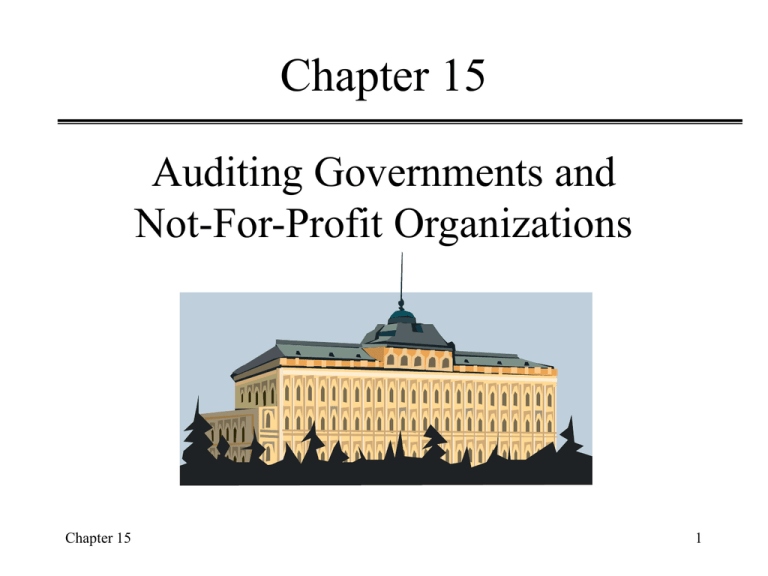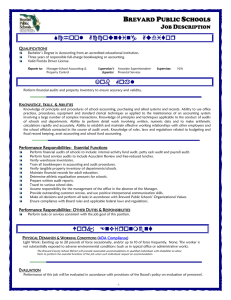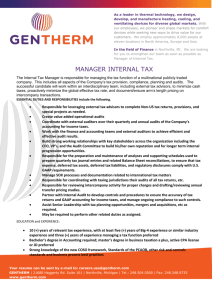
Chapter 15
Auditing Governments and
Not-For-Profit Organizations
Chapter 15
1
Learning Objectives
Differentiate between auditing in the government and
not-for-profit sectors and in the business sectors.
Influence of yellow-book on auditing
Types of audits that governments conduct
Standards of government audits
Single Audit Act
Auditor reports
Performance audits
-Characteristics
-Key elements
Impact of Sarbanes-Oxley on governments and not-for-profits
Ethical issues facing governmental and not-for-profit
accountants and auditors.
Chapter 15
2
Important Concepts
Understand very clearly what is meant by
-generally accepted government auditing standards
(GAGAS),
-the source of GAGAS, and
-why GAGAS are much broader than GAAS, in
particular for financial audits and performance audits
Chapter 15
3
Audits of Governments and
Not-For-Profits Vs. Business
Audit: examination of records or accounts for
accuracy.
Business sector audits: characterized by attest
function—to affirm to be true.
Government/Not-for-Profit sector:
-Auditors not only attest but also independently
evaluate.
-Assess whether auditees have achieved the
objectives.
Chapter 15
4
Influence of the Yellow Book
Yellow book: Government Auditing Standards
issued by the Government Accountability Office
(GAO).
Responsible for auditing all federal agencies.
Responsible for prescribing accounting standards
and practices of federal agencies.
Headed by Comptroller General of the U.S.
GAO:
-Issued to elevate auditing practice
-No direct control over state and local governments.
Chapter 15
5
Types of Audits
Government Auditing Standards (2003) characterize
government audits into three categories:
Financial Audits: determines if financial
statements are in accordance with GAAP.
Attestation engagements: Examine, review,
perform agreed-upon procedures
Performance Audits:
Effectiveness of internal controls
Effective usage of entity’s resources
Verifying that organization is complying with terms of
the law, grants, and contracts.
Chapter 15
6
Generally Accepted Government Auditing
Standards (GAGAS)
Standards issued by the U.S. GAO in its “yellow book.”
The Comptroller General of the U.S. appointed the Advisory
Council on GAS to review the standards and recommend
necessary changes.
The Council includes experts in financial and performance
auditing drawn from all levels of government, private
enterprise, public accounting, and academia.
FACTS: At the end of fiscal 2005, 85 % of the 1,752
recommendations made in fiscal year 2001 had been
implemented by the GAO!
Chapter 15
7
Generally Accepted Government Auditing
Standards (GAGAS)
A total of 32 standards for both
financial and performance audits
Required of auditors in a Single Audit
(for any organization that expends more
than $500,000 in federal sources in any
year).
Chapter 15
8
Audits
Government auditing standards are divided into:
General standards
Performed by a person with adequate technical training and
proficiency
Independence
Due professional care
Field work standards
Adequately planned and supervised
Understanding internal controls
Obtain competent evidential matter
Reporting standards
States whether the financial statements are in accordance
with GAAP
Identify inconsistencies, if any
Informative disclosures
Expression of opinion
Chapter 15
9
Generally Accepted Government Auditing
Standards (GAGAS) are Broader than GAAS
This gives an overview of the breadth and depth of GAGAS.
Financial
Audits
Attestation
Engagements
Performance
Audits
GAAS
GAGAS
GAAS
GAGAS
GAAS
GAGAS
General
Standards
3
4
5
5
0
4
Field Work
Standards
3
7
2
7
0
4
Reporting
Standards
4
11
4
9
0
4
Totals
10
22
11
21
0
12
Chapter 15
10
GAGAS audit categories
Financial statements audits
Financial related audits
Economy and efficiency audits
Program audits
-GAGAS standards place much more emphasis
on compliance with laws and regulations than do
GAAS
Chapter 15
11
Government Vs. Non-government Audits
General Standards:
Independence:
-Auditors should not perform management functions
-They should not audit their own work
-Should not provide nonaudit services.
In government sector, audit organization is
independent if:
-It is from a different branch than the units it is to
examine
-Whose auditor is elected by citizens of government’s
jurisdiction or appointed by legislative body.
Chapter 15
12
Government Vs. Non-government Audits (cont’d)
Standard on adequacy of professional competence requires
auditors to have:
– A thorough knowledge of governmental auditing and the specific or
unique environment in which the audited entity operates
– At least 80 hours of CE (CPE) every two years, of which at least 20 hours
must be completed in each of the two years and at least 24 hours of which
must be related directly to the
audit environment
Peer Review: has to be done at least once in 3 years.
Compliance: reasonable assurance in detecting fraud or
misstatements.
Working Papers
Standards of Reporting:
-Compliance
and Internal Controls
-Public Inspection
Chapter 15
13
Single Audit Act
Understand the characteristics of a single audit,
including:
– the purpose
– which entities must have a single audit
– what auditing work is required
– how major programs are selected for audit
– what reports must be rendered, when, and to
whom
Chapter 15
14
Single Audit Act (cont’d)
Intended (among other purposes) to improve the
efficiency and effectiveness of governmental audit
effort
By replacing a multitude of grant-by-grant audits
with a single, comprehensive, entity-wide audit
All federal awarding agencies are required to
accept the single audit reports as satisfying their
program’s audit requirements
Chapter 15
15
Single Audit Act (cont’d)
Congress enacted Single Audit Act of 1984.
Applies to both direct and indirect recipients of
federal assistance.
Requires organizations expending more than
$500,000 in federal assistance under more than
one program be subject to single audit.
Recipient has to deal only with single agency.
Single Audit be conducted in accordance with
GAO’s Auditing Standards.
Chapter 15
16
Single Audit Act (cont’d)
1996 Single Audit Act Amendments:
– Raises the threshold for a single audit from $100,000 received to
$500,000 expended
– Extends statutory requirement for single audit coverage to not-for-profit
organizations as well as state and local governments
– Establishes a risk-based approach for audit testing, thus placing greater
audit coverage on high risk programs
– Improves the contents and timeliness of single audit reporting
– Permits the Office of Management and Budgeting (OMB) to
administratively revise Single Audit requirements without
requiring additional legislation
OMB Circular A-133 and the related Compliance
Supplement provide implementing guidance for
conducting the single audit
Chapter 15
17
GAAS-GAGAS-Single Audit Relationships
Financial Audits
GAAS
Financial & Performance Audits
GAGAS
Single Audit
GAGAS Incorporates GAAS – and includes additional requirements
Single Audit Incorporates GAGAS – and includes additional requirements
Chapter 15
18
Single Audit Act and OMB Circular A-133
Did the nonfederal
entity expend
$500,000 or more of
federal awards?
No
No Single Audit or Program
Specific Audit required--only
GAAS and GAGAS Audit
required.
Yes
Did the nonfederal entity
1) expend federal awards under only
one federal program--which did not
require a financial statement audit,
2) meet other requirements, and
3) properly elect a program specific
audit?
Yes A program-specific
audit is required.
No
A Single Audit is required.
Chapter 15
19
Single audit objectives related to entity as whole
Fair presentation of financial statements
Compliance with laws/regulations
Where noncompliance may have material effect
on financial statements
Study and evaluation of internal controls
To determine audit procedures necessary to opine
on statements
Satisfies laws & regulations applicable to specific
federal award.
Chapter 15
20
Single audit objectives related to Federal
financial assistance programs
Fair presentation of schedule of FFA in
relation to financial statements
Adequacy of internal control systems
over Federal programs
Ascertain compliance with
laws/regulations with material effect in
each major Federal assistance programs.
Chapter 15
21
City of Austin - Financial Assistance Programs
The notes to the 2004 annual report for the City of
Austin include that:
– The City participates in a number of federally assisted
and State grant programs, financed primarily by the U.S.
Housing and Urban Development (HUD) Department,
U.S. Health and Human Services (HHS) Department,
and U.S. Department of Transportation (DOT). The
City’s programs are subject to program compliance
audits by the granting agencies.
– Management believes that no material liability will arise
from any such audits.
Chapter 15
22
Single Audit
Two main components:
-Audit conducted under GAGAS
-Audit of federal financial awards
Four types of reports
Opinions on the financial statements and Schedule
of Expenditures of Federal Awards:
-Includes the audit work and opinion on the statements
-The schedule includes a list of total expenditures of the
organization
-Proper categorization of expenses
Chapter 15
23
Single Audit Act Requirements
Annual audit encompassing the entity’s financial
statements and schedule of expenditures of federal awards.
Audit must be conducted by an independent auditor.
Auditor must determine whether financial statements
present fairly in conformity with GAAP and the schedule
of federal financial awards is presented fairly in relation to
the financial statements.
Auditor must obtain an understanding of internal controls
pertaining to the compliance requirements for each major
program, and assess control risk and perform tests of
control.
Federal and nonfederal “Pass-through” agencies are
assigned certain responsibilities for compliance
Chapter 15
24
Single Audit Act (cont’d)
Q: Who has to have an audit under GAGAS?
A: Any state or local government or not-for-profit
organization that expends at least $500,000 in
federal awards during a year must have an audit in
conformity with GAGAS.
– If expended only for one program or one program
cluster, the entity can have a program audit. Otherwise
the audit must be a single audit
Chapter 15
25
Single Audit Act (cont’d)
Calculation of amount of federal awards expended
– Calculation can be complex
– Basic rule is that a federal award has
been expended when the federal agency
has become at risk and the nonfederal recipient
has a duty of accountability
Chapter 15
26
Compliance Audits (as part of single audit)
For each major program the auditor must test
whether the program:
– was administered in conformity with the
appropriate OMB Circular (A-102 or A-110)
– complied with detailed requirements in the A133 Compliance Circular and other specified
requirements.
Chapter 15
27
Selection of Programs for Single Audit
Using a sliding scale identify “Type A” and “Type B”
programs
Identify low-risk programs (based on no audit findings in
most recent audit and absence of certain risk factors)
Assess risk of Type B programs (major programs that are
not Type A programs)
At a minimum, audit all high risk Type A programs and
either
– (1) half of the high-risk Type B programs or
– (2) one high-risk Type B program for each low-risk Type A program
Audit at least enough major programs to ensure that at
least 50% of total federal award expenditures are audited
Chapter 15
28
Risk-Based Approach
Step 1:
Identify (larger) Type A Programs
Step 2:
Identify “low-risk” Type A programs
Step 3:
Identify “high-risk” Type B programs
Step 4:
Select for audit as major programs a minimum of all
Type ‘A programs not identified as “low-risk” in Step
2, plus certain “high-risk” Type B programs.
Chapter 15
29
Reports of Single Audits
Report on compliance and on internal controls:
-Directed towards the basic financial statements
-Based on audit requirements Governmental Auditing Standards
-Include any material weaknesses in the controls
Report on compliance with the requirements of major
programs:
-Explain the nature of the examination
-Auditors express an opinion
-Include any “ reportable conditions”
Schedule of findings and questioned costs:
-Most distinctive and informative
-Summary of the results
-Describe reportable conditions
-Include findings pertaining to major programs
Chapter 15
30
Key Audit Procedures
Identify compliance requirements
Plan the engagement
Assess internal control
Obtain sufficient evidence
Consider subsequent events
Evaluate and report on noncompliance
Follow-up procedure
Chapter 15
31
Performance Audits
Focus on organizational accomplishments
Carried out by “internal” audit departments
General standards are common to both financial and
performance audits
3 sections include:
-General
-Field work
-Reporting
Auditors make independent assessments
Performance audits carried out on specific programs
Conducted irregularly
Broader range of evidence
Each performance audit is unique.
Chapter 15
32
Manner of Conducting Audit
Selecting audit target
Establishing scope and purpose
Discerning objectives
Scheduling disbursements
Assessing management controls
Written audit plan
Gathering evidence
Reporting the results
Chapter 15
33
Governmental Vs. Not-for-profit
Government employees are involved with ethical
decisions different from those faced by employees
of businesses.
Characteristics of Governments:
- Public expectations
- Guardians of public funds
- Activities carried out in open view
- Special Powers
- Conflicting loyalties
Chapter 15
34
Impact of Sarbanes-Oxley Act on
Government and NFPs
Even though the Sarbanes-Oxley Act (Act) applies only to
publicly traded corporations, it’s impact is being felt by
government and NFP organizations.
Key provisions of the Act that are relevant to government
and NFP organizations include:
-Section 404 which emphasizes the importance of sound internal
controls
-Responsibility of audit committees
-the Act mandates that CEO and CFO certify the financial statements
-the Act provides “whistle-blower” protection to employees.
Perhaps most importantly the Act changed the climate of
all organizations.
Chapter 15
35
Ethical Issues
Governments and to a lesser extent not-for-profits
have characteristics that present their employees
with ethical decisions that are different from those
faced by employees of businesses. These are:
Public expectations
Guardians of public funds
Activities carried out in open view
Special powers
Conflicting loyalties
Chapter 15
36
Summary
Auditors add value to information by being independent and conforming
to professional auditing standards (GAAS or GAGAS)
GAGAS are broader than GAAS in that they include standards for
financial and performance audits established by the government through
the GAO’s Yellow book.
Performance audits differ in concept from financial audits. It makes
assessments about an entity’s programs.
Under the Single Audit Act, GAGAS has to be adhered to in all audits of
both governments and not-for-profit organizations. However, the Single
audit requires only financial audits.
Single audits comprise 2 elements: an audit of financial statements and an
audit of federal financial awards that follows the provisions of OMB
Circular A-133.
The single audit improves both the efficiency and effectiveness of audits
of nonfederal entities with significant expenditures of federal award.
The Sarbanes-Oxley Act does not apply to government and not-for-profit
organizations but has affected their culture.
Chapter 15
37
Copyright © 2007 John Wiley & Sons, Inc. All rights
reserved. Reproduction or translation of this work
beyond that named in Section 117 of the United States
Copyright Act without the express written consent of the
copyright owner is unlawful. Request for further
information should be addressed to the Permissions
Department, John Wiley & Sons, Inc. The purchaser
may make back-up copies for his/her own use only and
not for distribution or resale. The Publisher assumes no
responsibility for errors, omissions, or damages, caused
by the use of these programs or from the use of the
information contained herein.
Chapter 15
38








